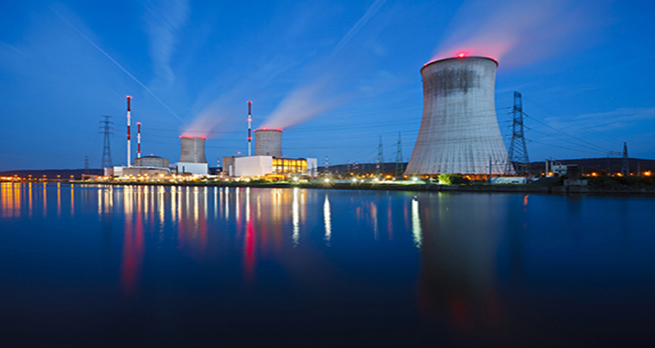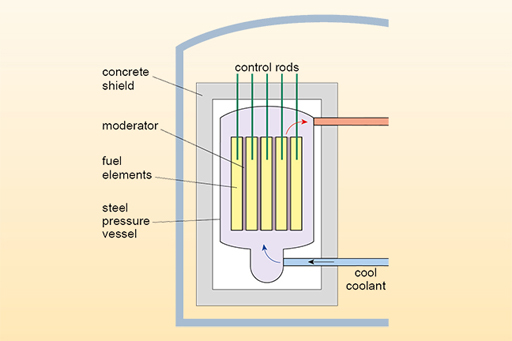2.2 Components of a nuclear power station
In essence, a nuclear power station is a system for maintaining a fission chain reaction and extracting the resulting heat.
The key to creating so many fission events is the two or three free neutrons that are typically released by each fission event. The chain reaction takes place in the core of the reactor, and the resulting heat passes into a fluid, or coolant, which is pumped through the core. The different components of a nuclear reactor are described below.
The fuel
The elements that undergo the fission are generally uranium (U) or plutonium (Pu). The fuel itself is normally in the form of uranium or plutonium dioxide (UO2 or PuO2). In UO2 the uranium is bonded to two oxygen atoms via its electrons but the nucleus of the uranium is still free to undergo fission, and the same is true of the plutonium in PuO2. The fuel is referred to as the fissile material as it undergoes fission.
The fuel is arranged in the form of a cylindrical rod (or a stack of cylindrical pellets) in a thin-walled metal container; often the metal is zirconium. The containing material is known as cladding and works as a physical barrier, preventing the fission products and fuel from entering or reacting chemically with the coolant. In practice, a nuclear fuel element will produce energy for three to six years before it needs to be replaced.
You will recall from last week that the majority of the products of fission are radioactive, and it is obviously important to prevent them from escaping from the reactor. The simplest way to do this is to keep them in the fuel and this is the purpose of the cladding.
The control rods
A nuclear fission reaction at criticality can be maintained by controlling the critical mass (as you heard about in Week 1). However, the critical mass will change as fuel is used up or even as the temperature fluctuates so a dynamic method is needed that can adapt to changing circumstances and control the neutron population.
The standard method for controlling a chain reaction in a nuclear power station is by control rods. Control rods are made from a material that absorbs neutrons. As the rods are inserted further into the fissile material, more neutrons are absorbed and so fewer fission events are triggered.
Other control methods may be used in addition to inserting rods. For example, some reactors have the option of introducing neutron absorbing material into the coolant in order to reduce the rate of fission.
The moderator
As you learned last week, induced fission is often more likely with neutrons of lower energy (slower) rather than higher energy (faster). If this seems counter-intuitive, imagine a golfer trying to putt a ball. The ball is more likely to be ‘captured’ by the hole if it is not going too fast.
If the free neutrons created by fission are not slowed down, they are described as fast neutrons. If they are slowed down to lower energies (the process of moderation), they are called thermal neutrons.
In the moderation process, fast neutrons are slowed down by interaction with a moderator. The moderator is a volume of a material such as hydrogen. The neutrons collide with the nuclei of the moderator and, in the process, are slowed down to the same average speed as those of the moderator. If the moderator is at room temperature, the neutrons emerge with a range of velocities typical of a material at this temperature.
The three most important isotopes used as moderators are:
- hydrogen in the form of light water H2O
- deuterium in the form heavy water D2O
- carbon in the form of graphite.
The coolant
The coolant is a gas or liquid that passes through the hot reactor core and carries away the heat produced. It flows around the fuel rods and is in contact with the cladding, rather than with the fuel itself. Apart from being able to remove heat from the fuel rods efficiently, coolants should not react chemically with the cladding, or with any other part of the cooling circuit, and they should not absorb too many neutrons. The coolant should also not be too expensive because a lot of it is used.
Taking all these factors into consideration, the coolants used in the majority of reactors are the gases carbon dioxide and helium, and liquid water.
If water is used as the coolant, it may be allowed to boil, and hence to produce steam directly for use in the turbine: this is called a direct steam cycle. Alternatively, the light water may be prevented from boiling by keeping it under very high pressure, and the hot water pumped to a steam generator, where steam is produced by heating a separate water supply: this is called an indirect steam cycle.
If a gas coolant is used, the gas that has been heated by the core is pumped to the steam generator, where steam is produced – this is also anindirect steam cycle.
Note that water can be used as both a coolant and a moderator – some nuclear reactors use water for both purposes.
In the next section you will see a diagram of a nuclear power station.

